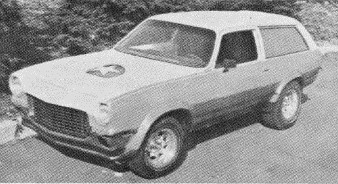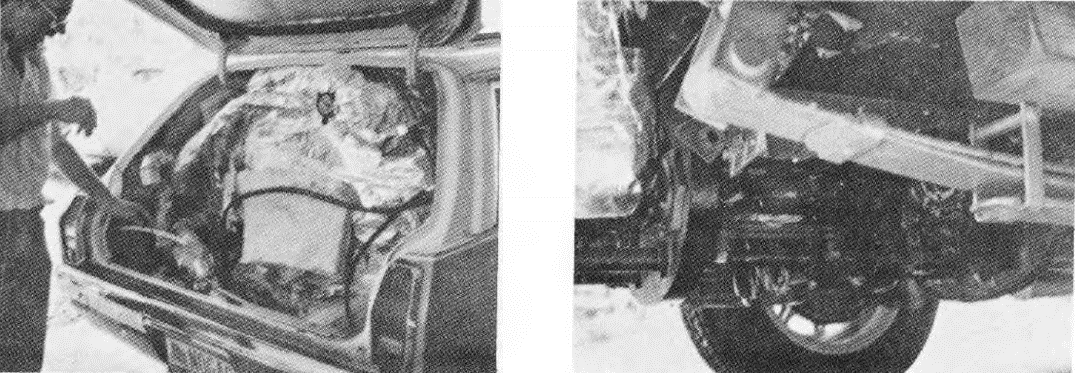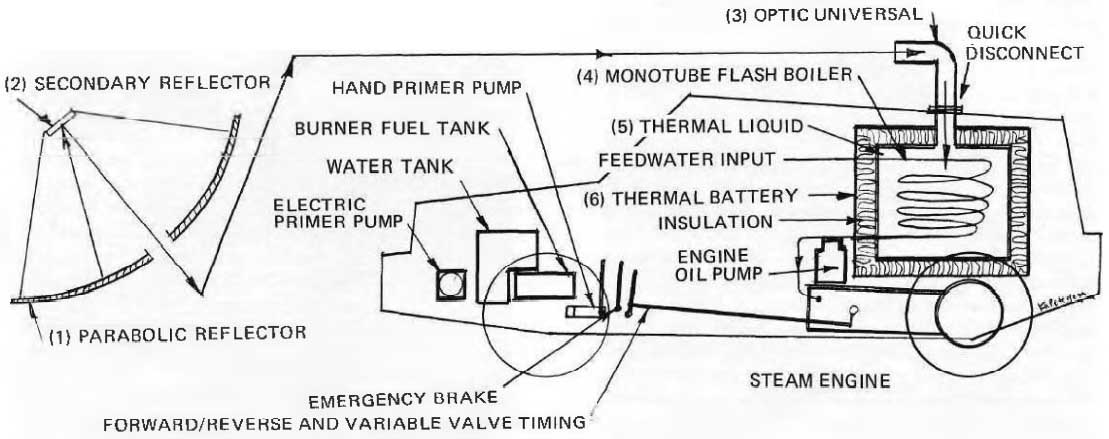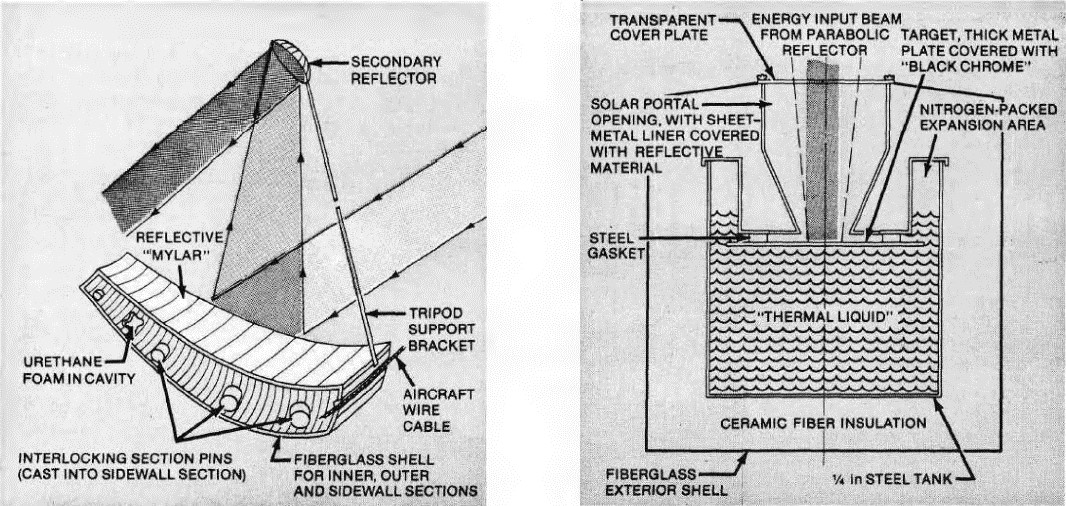
Solar powered steam vehicles
CSV needs these existing technologies to work--
Concentrated Solar Vehicle Components
Heat engine:
a small closed cycle steam engine or Brayton cycle engine drives the
vehicle just as an internal combustion engine or electric motor would.
It runs the wheels and all the normal vehicle systems. The most efficient could be a hybrid car in which the IC engine is replaced by a solar powered heat engine, since it can operate at an optimum load.
Solar Thermal
Container: a fairly large insulated compartment, in the
center of the chassis under the body holds the thermal storage medium.
This is insulated and not pressurized. Heat exchange tubes draw heat and
power the engine. Sandia's current G3P3 solar collection and storage project produces intensely hot, very safe to store thermal particles which can readily transfer heat to any heat engine.
Heat Transfer to
the CSV: The stationary storage solar heat medium can be quick-swapped into the vehicle just
as fast as filling a gas tank and lots faster than charging batteries. In a pinch, any heat source (electric, fuel, friction) can add heat for increased range or recharge away from the base storage.
Controls:
The accelerator pedal controls the amount of heat going to the engine. A
reverse neutral and park selector do the familiar things.
Solar Thermal Energy System --The Sandia G3P3 demonstration system. Local units around the world can provide microCHP power and heat and supply the heat for the CSV.
Here is an historic example of a demonstration CSV:
Modified Vega demonstrates
feasibility of automotive solar power
Design News,
Sept. 7, 1981. Daniel V. Edson, Associate Editor, Design News
On-board "thermal battery" can be charged by parabolic reflector to provide boiler heat for steam-driven experimental car. Widespread application of propulsion concept could result in sizable energy savings.
With a hiss and a burst of steam, the solar-powered test car jumped to life. I drove a short distance, eased to a stop, checked the steam-pressure and thermal-battery-temperature gages, shifted into reverse and returned. The car had moved smoothly with surprising power, and solely by heat energy stored on board.
An intriguing contrivance--a 1977 Vega wagon, stripped of its engine, transmission and drive shaft, and refitted with a 1915 Stanley engine, a monotube flash boiler and a 700 lb thermal battery--the experimental car effectively demonstrated the feasibility of using solar energy for vehicular propulsion.
The thermal battery, a unique heat reservoir and the key element in the design, contains a stable, high-temperature, heat-storage material that can be charged (heated) by a high-temperature solar concentrator, such as a parabolic reflector (for convenience a small oil burner charges the thermal battery during testing). Water pumped through the monotube boiler, which is submerged in the heat-storage material, produces steam to run the engine.

Solar-power test car built by American Solar Energy Corp., Arlington, VA, represents significant advance in applying solar energy to vehicular propulsion. Equipped with steam engine, flash boiler and "thermal battery" that can be charged by parabolic reflector, proof-of-concept vehicle theoretically can travel 35 miles at 55 mph on one, three-hour charge from the sun.
Designed and fabricated by Dr. Robert C. McElroy, president of the American Solar Energy Corp., Arlington, VA, the research vehicle has a theoretical range of about 35 miles at 55 mph on a single thermal-battery charge (roughly three hours with a 16-foot parabolic reflector in nominal sunlight). A production solar-powered car, built specifically for solar propulsion, would probably stretch that range to 80 miles or so, easily more than most Americans drive in a single day.
The solar-powered test car represents a basic, straightforward propulsion concept, one with the potential to reduce petroleum fuel consumption considerably.
400lb of BTU'S
Capturing the energy collected by a high-heat solar concentrator, such as a parabolic reflector, for use in a mobile application, is made possible by the heat-storage material in McElroy's patented thermal battery. The stable, tar-like, refinery byproduct, trademarked Thermal Liquid, can be heated to upwards of 1000F without igniting, degrading or creating high pressure.
Characterized by high density and high specific heat, Thermal Liquid absorbs and stores a large number of Btu's in a relatively small volume, minimizing the storage container surface area, and thus minimizing area to be covered by insulation against heat loss, and increasing portability. The Thermal Liquid composition in the test Vega has an auto ignition point of 620F (in oxygen), but chemists have advised McElroy that certain modifiers will raise the auto ignition point to 1000F or more. The material freezes at about 200F.
Though Thermal Liquid performs satisfactorily and is readily available and reasonably priced, McElroy continues to assess other possible storage media, including synthetic lubricants, to improve heat-storage efficiency. Phase-change salts offer some of the properties desired, but are considered too corrosive.

Dr. Robert C. McElroy, solar car designer, points out steam release valve at rear of insulated, foil wrapped thermal battery. Ceramic-fiber insulation surrounds tank, holding ambient heat loss to 60F per 24 hours, from a 600F charge. Temperature gauge, visible at top of thermal battery, reads 475F. (Design News photo)
Sun-charged battery
Major components in the solar-power test vehicle include the thermal battery (with monotube flash boiler), feed water pump and engine. The Thermal Liquid and the monotube boiler are contained in a rigid, 275 lb. 1/4 inch steel tank positioned behind the front seats in the area normally occupied by the back seats and luggage. (The area available for the tank dictated the size of the storage battery--and likewise the estimated range.) To install the tank,
McElroy ripped out the floor and the front and back seats and replaced the floor with aluminum (diamond tread), and the front seats with light bucket seats.

The tank is insulated by Cer-Wool, a high R insulation holds ambient battery losses to about 60F per day from 600F plus.
A parabolic reflector would charge the thermal battery in a truly solar-powered configuration, but the reflector is considered a proven component and has not been used in testing. The reflector would be stationary, perhaps mounted beside the driveway or on top of the garage (or used in conjunction with residential heating/cooling equipment), with a quick disconnect optical universal connecting the reflector to the thermal battery. Solar energy reflected by the reflector face to a secondary receiver above the reflector would be transferred through the optic universal to a target plate in the thermal battery. The 400 lbs of Thermal Liquid in the thermal battery contains about 200,000 usable Btu, figuring a 375F to 620F working-temperature range. A 16-foot parabolic reflector, with 80% efficiency, could net a conservative 60,000 Btu/hour, considering system losses, and could recharge the battery in a little better than three hours. (Geographical location, of course, has an impact on charging time and the size of the parabolic reflector.)
The back-up heat source, which has been charging the thermal battery exclusively during tests, consists of a simple, high-efficiency oil burner, installed in a tube leading into the thermal battery. Roughly equivalent to a 16-foot parabolic reflector, the burner recoups one day's ambient heat loss in about 1 hour.
An expansion area at the top of the thermal battery accommodates the expansion and contraction of the Thermal Liquid as it is heated and cooled.
Mylar coated fiberglass parabolic reflector with interlocking sections combines strength and light weight. In nominal sunlight, 16-foot reflector could recharge thermal battery in solar-powered car in roughly three hours.
To keep the storage material from combining with oxygen, which would promote degradation, the expansion area is charged with a couple of pounds of nitrogen.
The flash boiler, submerged in the Thermal Liquid in the thermal battery, connects to the feedwater line at the top of the tank. (McElroy installed a removable panel in the roof to expose the connection). To keep steam in the boiler from backing up into the feedwater line, causing a vapor lock, the feedwater line connects first to an aluminum fitting--a thermal barrier--then to a steam check valve before meeting the stainless steel boiler.
The heat energy stored in the thermal battery has been satisfactory for the steam quantity and pressure required, but the monotube boiler is unable to keep up under high demand conditions. As a result, McElroy will replace the existing boiler by a boiler with a one-gallon reservoir inside the thermal battery, an engineering change that should alleviate the low-steam problem.
$50 per hp.
McElroy contacted a number of steam car owners before finding a steam enthusiast in Pennsylvania willing to part with an applicable engine, a 20 HP, 2-cylinder Stanley engine. Ironically, McElroy paid $1000 for the steam engine, manufactured in about 1915, but recovered only $125 when he sold the engine from the four-year-old Vega.
Steam engines, which are noted for simplicity and low parts count (21 moving parts in this engine), provide high torque at low speeds and do not require unique thermal battery provides 200,000 usable BTUs for solar-power test car. Containing stable, high-temperature, high-density, high-specific-heat "Thermal Liquid'" battery can be charged by stationary parabolic reflector through an optic universal.

gearing to accommodate low-speed operation. Because steam is injected into one end of each cylinder each stroke (exhausted at the opposite end), with intake and exhaust valves reversed for the return stroke, this two-cylinder steam engine has four power strokes per revolution and turns 773 revolutions per mile, in effect 3092 power strokes per mile.
The engine hangs under the car, between the rear axle and the rear bumper. (Integrating the steam engine to the Vega required as much dexterity with a torch as familiarity with automotive design.) Because the engine is built on four lag screws that pass through the axle housing, McElroy had to cut and weld the housing extensively. In addition, he was forced to grind out the housing to accommodate an 8-inch industrial flat-cut gear that had been hollowed to fit over the stock Vega carrier. A sheet metal cover (not installed during my test drive), holds oil for splash lubrication.
A small, 1/4-ton truck frame was substituted for the stock rear end to handle the weight of the Stanley and the thermal battery. The springs in the rear, however, are not adequate and McElroy has wedged a block of wood between the floor and springs to keep the suspension from bottoming until heavier springs can be installed. (Even with the added load in the rear, the Vega weighs approximately 400 lb less than delivery weight.)
To provide lubrication for the cylinders, McElroy chose a Detroit lubricator--an antique, but still rugged, reliable and easily metered.
Similar to lubricators found in later Stanleys, the pump squirts 600 weight cylinder oil into the engine each revolution (squirt being a stretch of the imagination). The pump runs so slowly that it took 3000 oscillations to move oil from the pump, mounted on the floor between the seats and the thermal battery, to the engine when the lubricator was installed.
The engine turns over at 100 psi, runs quite adequately at 200 psi, and is red lined at 600 psi; for my test drive we charged it to about 375 psi. A floor mounted lever controls direction--forward or reverse--and variable valve timing (the length of time steam is injected each stroke, an efficiency boosting economizer).
Priming and condensing
Once the Stanley is running, a power takeoff from the engine drives a water pump (an 800 psi high-pressure car-wash water pump in the Vega), assuring an adequate supply of feedwater. Getting started, however, requires a primer pump to jack up the steam pressure.
McElroy installed two primer pumps, in the test car, one hand-operated, the other driven electrically. The electrical pump, jerry-rigged to a 3/8 inch Black and Decker drill in a fixed position under the hood, has not performed as intended due to an inverter problem. At present, McElroy uses the drill only for static tests, since he must plug it into a wall socket. The hand-operated primer pump, infinitely more interesting, is an authentic Stanley brass pump, designed a good 75 years ago. Mounted on the floor between the seats, about where a gearshift might be positioned, the pump can achieve 1000 psi or better. At present, exhaust steam flows through a feed water preheater, an oil trap, then is exhausted.
Though a condenser is important--and though McElroy has experimented with a couple of designs--it is not a major thrust in this demonstration because a production solar powered car would not use water as a working fluid, eliminating the problem of separating heavy lubricant from steam.
Solar powered car in production
McElroy does not intend to develop this particular design much further. Beyond installing the new boiler with the one-gallon reservoir and making some full range road tests, the car will see few other refinements.
The next step involves applying the lessons of this proof-of-concept demonstration to a true solar powered prototype, built from the ground up. In a production solar-power-car-design, for example, the thermal battery might contain a heat storage material with higher temperature capability, higher specific heat and higher density, to increase the number of usable Btu's stored in a given volume.
Also, the thermal battery in a production car would be reconfigured for safety. McElroy suggests putting the well-insulated thermal battery inside the rectangle formed by the automobile frame, secured with shock absorber mounts. In a collision, the mounts and insulation would damp the tank movement, while the frame would physically protect it.
Attaching the passenger compartment to the battery, McElroy adds, could afford the passenger compartment the same shock absorption and cushioning given the thermal battery.
The engine in a modern solar power vehicle using McElroy's thermal battery would not be steam powered at all, but would use a low boiling point medium, such as Freon. In addition, the engine would have smaller bores, longer strokes and probably more than two cylinders, and would be designed for more complete expansion of the working fluid (or optimized variable valve timing) aiming for phase change at the end of the stroke. Engine efficiency in a production model might still be comparatively low, but it remains that the engine will operate only on demand (i.e., not when the car is stopped in stop-and-go traffic, or at traffic lights), and it will operate on an energy source that is renewable and, in a sense, free.
Sizing and siting parabolic reflectors is another application detail, but not insurmountable. Available sun in a particular locale, of course, will determine size of parabolic reflector and length of charge.
To accommodate commuter cars, cars driven to the train station, cars not at home during the day (where a reflector most commonly would be), employers and municipalities might erect parabolic reflectors in parking lots, charging stations paid for by the hour. Going a step further, collapsible reflectors could be designed--reflectors folded on the top of a car that the driver could pop open to charge the thermal battery while the car is parked.
McElroy recognizes the innate inconvenience of being tethered to a parabolic reflector, and even now is working on a solar car design with self-contained charging components. He envisions concentrating lenses built into the body of the car, lenses that would provide energy for a flash boiler or charge the thermal battery, depending on the need, whenever the car is in the sun, driven or parked. Ultimately, he projects, an integrated solar powered car could be driven nearly nonstop on a sunny day without using backup energy sources.
A concept stalled?
Plugging into a backyard parabolic reflector may not be every driver's idea of convenience, but given the outlook for fuel availability and cost, that prospect will be less odious as time goes on. McElroy estimates that a four-seat, compact solar car could be manufactured in production for close to the cost of a conventional compact car, less the parabolic reflector. He also estimates that such a car could be on the road in the next decade--if research continues.
The climate for funding for this type of venture has grown foul in recent years, and shows no sign of improving. Both government and industry in this country, for a multitude of reasons, have cut spending on numerous promising energy-saving ideas, flywheel propulsion and continuously variable transmissions being two excellent examples. Whether the concept demonstrated by McElroy is investigated further to determine its true potential, or whether the red, white and blue Vega with the NOGAS license plate remains parked in a driveway in Arlington, VA, remains to be seen.
[Dr. McElroy's contact information ]
Sandia's E3P3 Program for Solar Heat Storage
History
Augustin Mouchot demonstrated a solar collector driving refrigeration equipment making ice cream at the 1878 Universal Exhibition in Paris. The first installation of solar thermal energy equipment occurred in the Sahara approximately in 1910 by Frank Shuman when a steam engine was run on steam produced by sunlight. Because liquid fuel engines were developed and found more convenient, the Sahara project was abandoned, only to be revisited several decades later.[1]
Vehicle applications have an historical precedent in the work of John Ericsson in solar power operation of heat engines.
Stirling/Ericsson engines give higher efficiency than the kinds we use in trucks and cars today. But they're naturally heavier and slower. Ericsson tried to power a ship with one and it was far too big and heavy. Later he saw that his engine would be effective when heated with a parabolic solar heater. He did not have an interest in storage or road vehicles. John Leinhart discusses this.
Many fireless steam locomotives are in use in switching and tug applications, and these are still commercially offered. Usually these are heated by burning fuel and even electrically, but there is no reason solar heat could not be used. These would be commercial CSVs with relatively little development.
This page powered by ![]() , created with Netscape
Composer and last updated on 20 May 2024. Copyright 2024 Karl A.
Petersen who gets mail on yahoo at karlpete 208 340 4570
, created with Netscape
Composer and last updated on 20 May 2024. Copyright 2024 Karl A.
Petersen who gets mail on yahoo at karlpete 208 340 4570